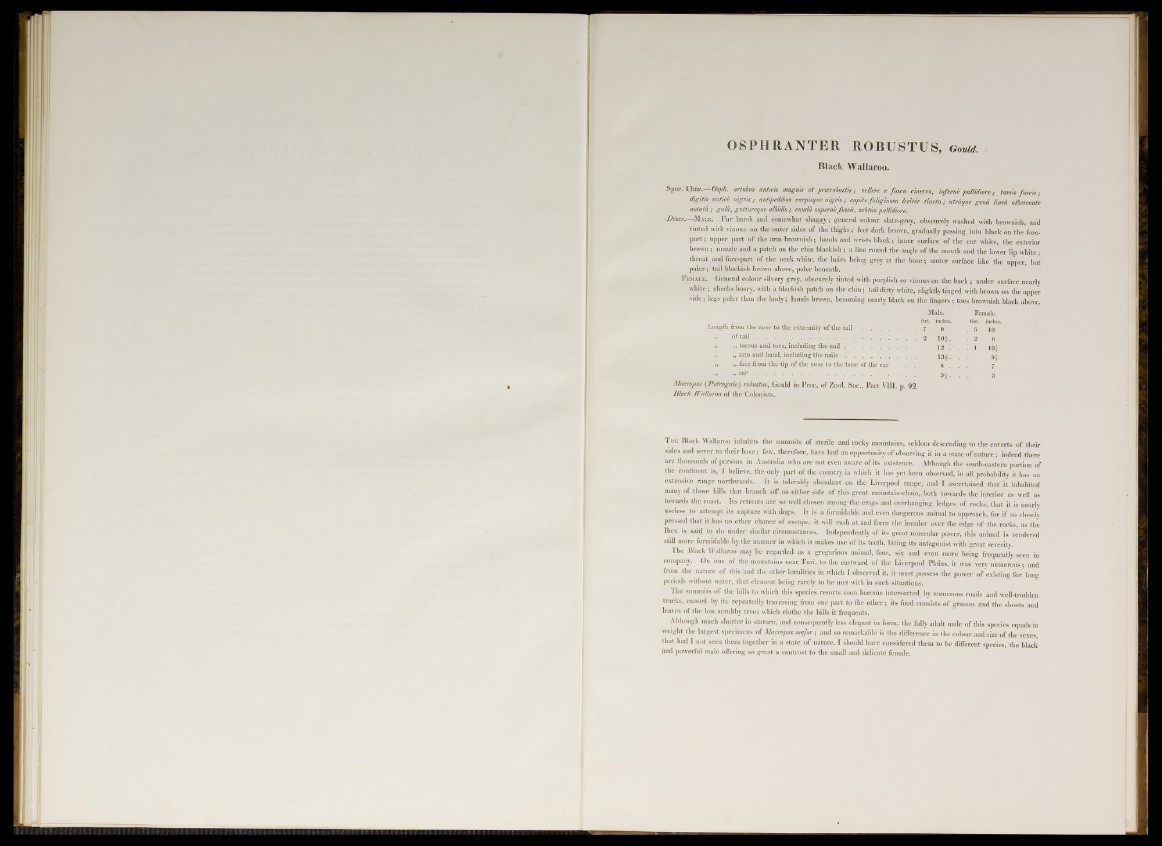
OSPHRANTER ROBUSTUS, Gouid.
Black Wallaroo.
Spec. Char.— Osph. artubus anticis magnis el prearobuslis ; tellere e /m e o cinéreo, inferno pallidiore; tarsis f is c is ;
digifa antice nigris ,■ anlipedibus carpisque nigris ¡ capitefuliginoso leoitér lin d o ; atraque genii linea albescente
notata ; gula, guttureque albidis; cauda superne fusca, subtus pallidiore.
/W .—M a l e . Fur harsh and somewhat shaggy; general colour slate-grey, obscurely washed with brownish, and
tinted with vinous on the outer sides o f the thighs; feet dark brown, gradually passing into black on the forepart
; upper part o f the arm brownish; hands and wrists black; inner surface o f the ear white, the exterior
brown ; muzzle and a patch on the chin blackish ; a line round the angle o f the mouth and the lower lip white ;
throat and fore-part o f the neck white, the hairs being grey at the base; under surface like the upper, but
paler; tail blackish brown above, paler beneatb.
F e m a l e . General colour silvery grey, obscurely tinted with purplish or vinous on the back; under surface nearly
white; cheeks hoary, with a blackish patch on the chin; tail dirty white, slightly tinged with brown on the upper
sid e ; legs paler than the body; hands brown, becoming nearly black on the fingers ; toes brownish black above.
Male. Female.
feet, inches. feet, inches.
Length from the nose to the extremity of the tail . . . . 5 10
,, of t a i l ................................................ . 2 6
,, ,, tarsus and toes, including the n a i l ...................... 12 . . . 1 10^
,, . arm and hand, including the nails , . , 9*
„ „ face from the tip of the nose to the base of the ear . 8 . .
„ • « e a r ................................................ 3
Macropus (Petrogale) robustas, Gould in Proc. o f Zool. Soc., Part VIII. p. 92.
Black Wallaroo o f the Colonists.
T h e Black Wallaroo inhabits the summits o f sterile and rocky mountains, seldom descending to the coverts o f their
sides and never to their base; few, therefore, have had an opportunity o f observing it in a state o f nature; indeed there
are thousands o f persons in Australia who are not even aware o f its existence. Although the south-eastern portion of
the continent is, I believe, the only part o f the country in which it has yet been observed, in all probability it has an
extensive range northwards. It is tolerably abundant on the Liverpool range, and I ascertained that it inhabited
many of those hills that branch off on either side o f this great mountain-chain, both towards the interior as well as
towards the coast. Its retreats are so well chosen among the crags and overhanging ledges o f rocks, that it is nearly
useless to attempt its capture with dogs. It is a formidable and even dangerous animal to approach, for if so closely
pressed that it has no other chance o f escape, it will rush at and force the invader over the edge o f the rocks, as the
Ibex is said to do under similar circumstances. Independently o f its great muscular power, this animal is rendered
still more formidable by the manner in which it makes use of its teeth, biting its antagonist with great severity.
The Black Wallaroo may be regarded as a gregarious animal, four, six and even more being frequently seen in
company. On one o f the mountains near Turi, to the eastward o f the Liverpool Plains, it was very numerous; and
from the nature o f this and the other localities in which I observed it, it must possess the power o f existing for long
periods without water, that element being rarely to be met with in such situations.
The summits o f the hills to which this species resorts soon become intersected by numerous roads and well-trodden
tracks, caused by its repeatedly traversing from one part to the other; its food consists o f grasses and the shoots and
leaves o f the low scrubby trees which clothe the hills it frequents.
Although much shorter in stature, and consequently less elegant in form, the fully adult male o f this species equals in
weight the largest specimens o f Macropus major; and so remarkable is the difference in the colour and size o f the sexes,
that had I not seen them together in a state of nature, I should have considered them to be different species, the black
and powerful male offering so great a contrast to the small and delicate female.